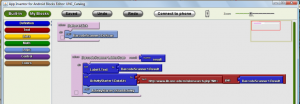 Earlier this week, Virgin launched an interesting new project. It’s called, well, ‘Project’. Project is essentially an iPad-only magazine. The key word is only. I’d link you to an article in the magazine, but I can’t.
Earlier this week, Virgin launched an interesting new project. It’s called, well, ‘Project’. Project is essentially an iPad-only magazine. The key word is only. I’d link you to an article in the magazine, but I can’t.
See, Project has no real web presence. They maintain a blog, but that blog’s content is entirely separate from the app’s articles. The only way to read those articles is via the iPad app ($2.99/issue). This restriction cuts to the heart of my ongoing concern with app culture. As I’ve said before, Apps lock up data and go against one of the central ideas and advantages of the open web – the ability to link between pages.
Project could have the most fascinating articles in the world, and nobody would know. The Project app has no copy/paste option, no real export ability at all. The only included export feature (and I use that word loosely) is emailing a screenshot of one page of an article to someone. I’d be embarrassed to share info with anybody that way.
Without the ability to link articles, Project loses out on the magic Google juice. The only way to find text in the article is by random browsing through the pages. Nobody will ever just stumble across a Project article unless they were specifically looking for it in the first place.
 I understand that Project wants to experiment with magazines in the emerging tablet world. And it admittedly has some nice features integrating video and slideshows into the pages (Jeff Bridges wanders around the cover and a couple of interior pages while you read (see screenshot), and the effect is not unlike a photograph from Harry Potter). But locking all the content inside an app is a huge misstep.
I understand that Project wants to experiment with magazines in the emerging tablet world. And it admittedly has some nice features integrating video and slideshows into the pages (Jeff Bridges wanders around the cover and a couple of interior pages while you read (see screenshot), and the effect is not unlike a photograph from Harry Potter). But locking all the content inside an app is a huge misstep.
Why not go after the tablet market with an HTML5 webpage instead? I’m willing to bet that 90% or more of Project’s multimedia functionality could be replicated on the open web. The result would be cross-platform (other future tablets could read it too), and the content would be linkable and Googleable. Lock it behind a subscription wall if that’s the desired business model, whatever. But on the open web users could at least stumble on an abstract or summary. Just put it on the web somehow. I’m not saying Project’s content is particularly amazing, but with the existing model how would anybody even find out? It’s impossible to post a link to an article on my blog, twitter account, or anywhere else.
Or please, at least allow readers to copy and paste text snippets. If I ever wanted to quote a Project article, I’d have to transcribe the text word by word. In the year 2010, that’s insane.
Apps have their place, but locked-down magazines aren’t it. This kind of thing hurts the internet.




